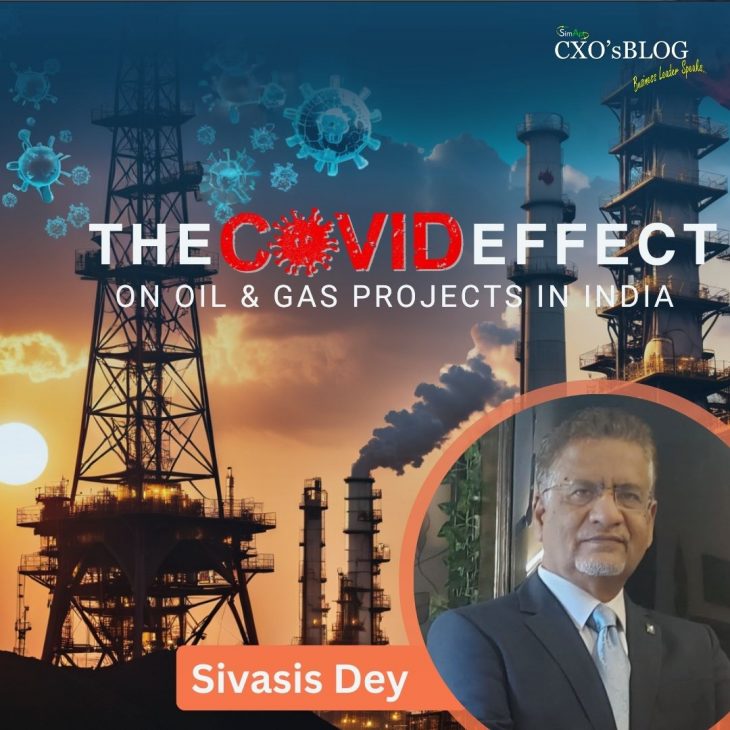Author: Sivasis Dey
The Oil and Gas sector plays a crucial role in influencing decision-making for other important sectors of the economy. India’s economic growth is closely related to its energy demand and therefore the need for growth of the petroleum sector, making the sector conducive for investment. India retained its spot as the third-largest consumer of oil in the world as of 2021. The Government has adopted several policies to fulfill the increasing demand and has allowed 100% Foreign Direct Investment (FDI) in the petroleum sector, including natural gas, petroleum products, and refineries, among others.
As a Senior Consultant from the Downstream Oil & Gas Sector, had the opportunity to have an in-depth view of the mega oil and gas projects in India, which took off before the Covid pandemic and got affected mid-stream. The projects being from the different verticals of Oil Industry, ranged from green field Refinery projects, capacity augmentation to existing Oil Refineries, new Petrochemicals Unit, cross-country product and gas pipelines, LNG ( Liquefied Natural gas) Import Terminals, LPG (Liquefied Petroleum Gas) Import Terminal, Crude Oil Terminal, City Gas Distribution (CGD) projects and many more. The Covid pandemic had impacted all, irrespective of the size and capacity, in a big way, in terms of time and cost overrun.
If one can recall, the deadly virus made its impact in India from February 2020. As it gained momentum, different protocols and administrative measures were implemented by the Government of India / State Governments. With the announcement of lockdown from 25thMarch, 2020 on a pan India basis, the different project sites were completely shutdown. The situation continued till August 2020. Thereafter, restrictions were imposed by local administration on the movement of people, construction materials and equipment. Again, during the second wave of Covid-19 pandemic, the sites were required to be shutdown during April 2021 to June 2021 and with the embargo on use of oxygen for industrial purposes. All these factors severely impacted work at the project sites. Even after gradual relaxations announced by the local authorities and Central government, it took substantial time for restarting the site activities, following all the protocols, with the workforce slowly joining back.
The tendering processes during the above period were also delayed, due to postponement of tender submission dates, owing to lock-downs/other restrictions in movement. Most of the bidders, including international bidders were unable to submit their bids for major units, as they could not complete the required engineering and could not obtain quotes from their sub-vendors located in different parts of the world. And they, therefore, requested for repeated extension of bid due dates. This resulted in delayed finalization of tenders, equipment procurement and Contractor appointment and thereby resulting in time and cost overrun. The time overrun spanned broadly from 1-2 years depending on the nature and the size of the projects.
In the meantime, the geopolitics of the Russian-Ukraine war in February 2022 made things even more difficult. The cost of steel, cement, other building materials, and engineering equipment hit the ceiling during this time. Some of the tenders were finalized at the time when the material costs were at its peak, thereby resulting in substantial cost escalation as far as hard costs are concerned. The extended date of the Scheduled Commercial Operation Date (SCOD) due to time overrun also increased the other overheads in terms of cost of manpower, cost of interest, etc., which again escalated the soft costs, thereby increasing the total project cost.
In view of the changed dynamics of the extended commissioning timeline, the viability of the Projects necessitated a re-look. The primary factor to assess the viability of oil & gas projects is the sales and revenue realization, keeping an eye on the Internal Rate of Return (IRR) & Debt Service Coverage Ratio (DSCR).
According to India Energy Outlook 2021, primary energy demand is expected to nearly double to 1,123 million tonnes of oil equivalent, as the country’s gross domestic product (GDP) is expected to increase to US$ 8.6 trillion by 2040. This reflected favourably on the estimated demand projections, be it the automotive fuels – Motor Spirit (MS) and High-Speed Diesel (HSD), other products like Aviation Turbine Fuel (ATF), Liquefied Petroleum Gas (LPG), Liquefied Natural Gas (LNG), Compressed Natural Gas (CNG), Petroleum coke, or Petrochemicals. The estimated demand numbers looked intact over the 15-20 year horizon as per is concerned reliable studies. As far as the price realization is concerned, the pricing being linked to the international crude oil price and domestic market condition, no significant impact on viability surfaced, in spite of the cost over-run. Sensitivity analysis indicated favourable DSCR under all possible adverse conditions, which again reveals reassurance on the viability of the Projects.
The Covid Pandemic was an uncontrollable factor and considered force majeure. However, a critical observation from the project updates indicate that post-pandemic, the Project Companies and the Project Management Consultants (PMCs), were quick to review the Project status and develop catch-up plans to reduce the delay and commissioning of the projects as per the revised plan. Mitigation measures in terms of augmentation of manpower and machinery, introducing extra working hours, incentive-oriented target plans for the workforce, etc., have been implemented which have paid off.
